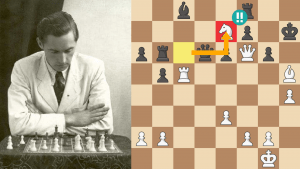
After the Rules, What Should Beginners Study Next?
member Sulpolitix asked:
As a beginning chess player, I would like to know the next thing I should learn after I learn how the pieces move.
Dear Sulpolitix:
I will deal with this from the perspective of a chess teacher, and what information he would feed a player who has just absorbed the most basic rules.
After a person learns how to move the pieces (with POINT COUNT being a part of that – it’s important he know the generic value of the pieces: Pawn – 1, Knight & Bishop – 3, Rook – 5, Queen – 9, and the King – priceless), the teacher needs to give the student quizzes that help him understand HOW THE PIECES AND PAWNS INTERACT WITH EACH OTHER. He’ll supply him with many simple positions that feature captures (you capturing his pieces and his pieces threatening to capture yours), pointing to a square and asking which of your pieces can go there, etc. Lots and lots of this very basic stuff is a huge help to the beginner, and not only prevents him from tossing his own guys away, but also makes him aware of opportunities to chop off enemy bits.
A mix of very simple and mildly complicated examples of piece interaction will keep the student on his toes. Here’s an example of a rather complex situation. Black to move seems to be able to capture on e4 with his Bishop, g4 with his Knight, and e5 with his Rook and d6-pawn. But is all that legal or good? And does White threaten anything? And what about 1…f5, threatening both e4 and g4. Would 1…f5 2.Bxf5 be a good reply?
Note that, in this example, it's not important who is and isn't better. What is important is that the student note all the possible captures and threats.
One very basic form of piece interaction is CHECKMATE and STALEMATE, and this needs to be clearly explained since many beginners are confused by the differences between the two.
1…Rxa3 is mate since the King is in check and has no way of removing the checking piece or stepping out of the check. The tempting 1…Qxb3?? seems powerful, but that would result in a draw by stalemate since white’s King is NOT in check, has no legal moves, and his Bishop is also not allowed to move since that would allow …Rxa1.
Once all the piece movements/interactions are hardwired into the player’s head, and once he has a good feel for how they can threaten, take, and defend other pieces, it’s time for these four oldies but goodies:
* DEVELOP ALL YOUR PIECES as rapidly as possible!
* CASTLE as quickly as you can!
* Use your pieces and pawns to CONTROL AS MUCH OF THE CENTER AS POSSIBLE. It might seem early to give this kind of quasi-advanced material, but instilling a desire to own the center sets up good habits down the line, and also compels beginners to develop their pieces towards the middle of the board.
* ROOKS BELONG ON OPEN FILES! This is important to toss at the student right away! Why? Because he’s going to find that it’s far from easy to get his Rooks into play (since the pawns curtail their activity). Show him how his pawns block his Rooks, and give him examples of purposely trading the blocking pawns off so the Rooks can have scope. This will prove a tad advanced, but do it anyway since the ideas will linger in the student’s subconscious mind.
Of course, the teacher will give many examples of all four of these things, and test the student with problems and perhaps even mini-games, which would ensure the previous lessons are rammed home.
Next up, the main MATING/ATTACKING POSITIONS that beginner’s see over and over again. These are back rank mates, and breakthroughs against f2/f7, g2/g7, and h2/h7.
It’s black’s move, and he has a massive material advantage, but he has no defense against Qg7 mate.
Our next position once again features a huge material plus for Black (who threatens 1…Qxb2 mate), but since White has the move he can claim victory by Qxh7 mate.
We've seen g7 fall, and then h7 also led to black's demise, but what about f7?
In the next example, white’s two pieces down, but he’s saved by a back rank mate combination via 1.Qe8+ Rxe8 2.Rxe8 mate.
Lots of problems like this, some simpler and some harder, will brutally push home the basic mate lessons.
The most basic ENDGAMES would follow. I would teach him 2 Queens vs. Lone King, 1 Queen vs. Lone King, 2 Rooks vs. Lone King, and 1 Rook vs. Lone King.
After these common mates and basic endgames are mastered, I would have him play as many games as possible online, at a chess club, anywhere that offers him an opponent that’s a tad better than him. The teacher would go over these games and point out where he failed to follow the previous lessons.
Also, once I had all of these things firmly entrenched in the student’s brain, I would leap into tactics, tactics, and more tactics. Thus, I’d teach him all the basic tactical themes and all the basic mating patterns. These don’t have to be mastered right away, but it’s important that the student is introduced to them:
TACTICAL THEMES
Clearance Sacrifice
Decoy, Pin, and Family Fork
Deflection and X-Ray
Double Attack
Skewer
Windmill
Zwischenzug
MATING PATTERNS
Anastasia’s Mate
Blackburne’s Mate
Boden’s Mate
Damiano’s Mate
Greco’s Mate
Légal’s Mate: This pattern often turns up in the openings of beginners. It’s based on two things: 1) an undefended enemy Bishop on g4; 2) the possibility of a mate delivered by two Knights and one Bishop.
The first recorded instance of this mate dates from 1750 in a game of Légal’s. A typical sequence leading to our desired situation might arise as follows: 1.e4 e5 2.Nf3 d6 3.Bc4 Bg4 4.Nc3 a6?? and now White plays the surprising 5.Nxe5! At this point Black should accept the loss of a pawn and play 5...dxe5 6.Qxg4. However, most beginners would be so excited by the fact that White has “hung” his Queen that they would play 5...Bxd1?? without hesitation. Then comes 6.Bxf7+ Ke7 7.Nd5 mate!
Morphy’s Mate
Pillsbury’s Mate
Réti’s Mate
Rook, Knight and Pawn Mate
Smothered Mate
I would also have the student buy a book of an old time player's best games (Alekhine’s best game collections by Alekhine is a great way to start!) and go over them when time permitted. He wouldn’t understand most of what’s going on, but this one collection of games/notes would begin his education about chess history, introduce him to his first chess hero, help him subconsciously absorb patterns, and give him a feel for the intensity that’s present in all high level games. You can't ask for more than that!
At this point I would no longer consider the student to be a beginner! It's only now, when our former beginner has reached a 1000 - 1100 rated level, that I would begin to teach basic positional ideas (mainly weak pawns, space, and weak squares). That way his foundation would have a modicum of balance and greater gains would be possible down the line.






